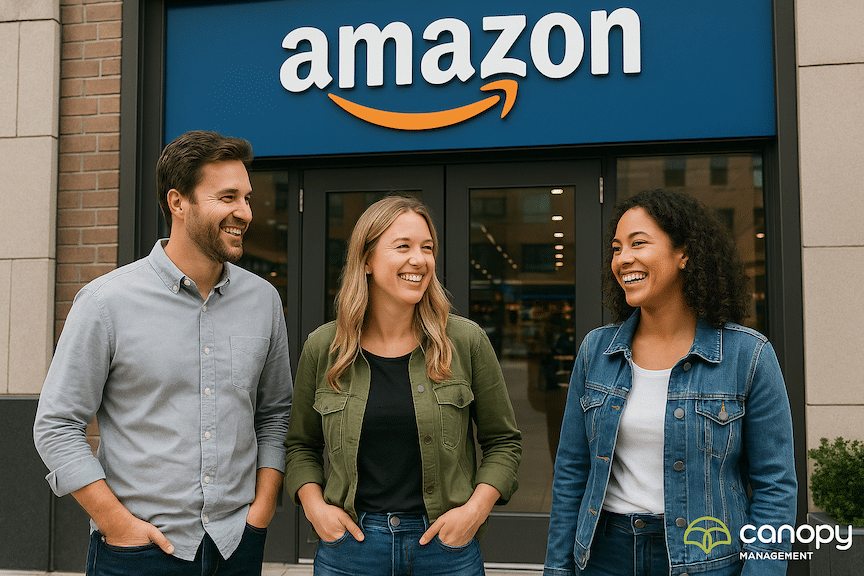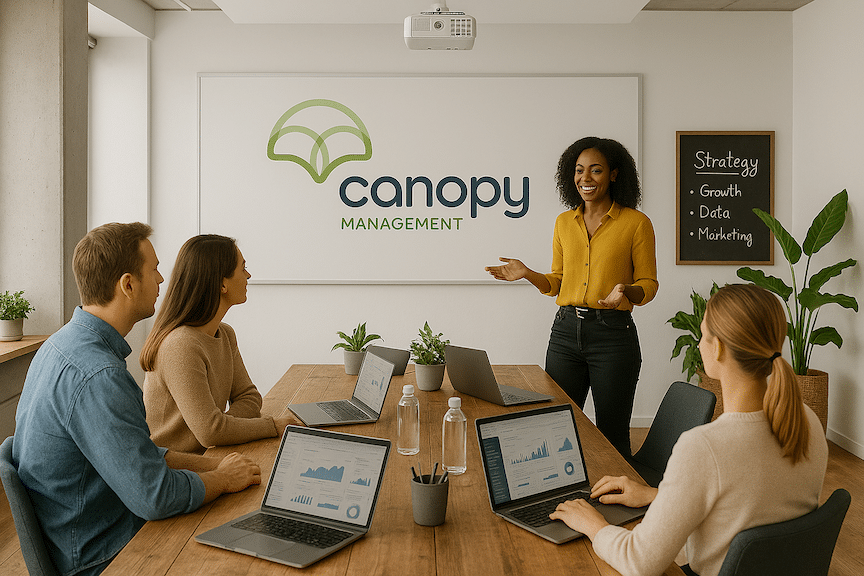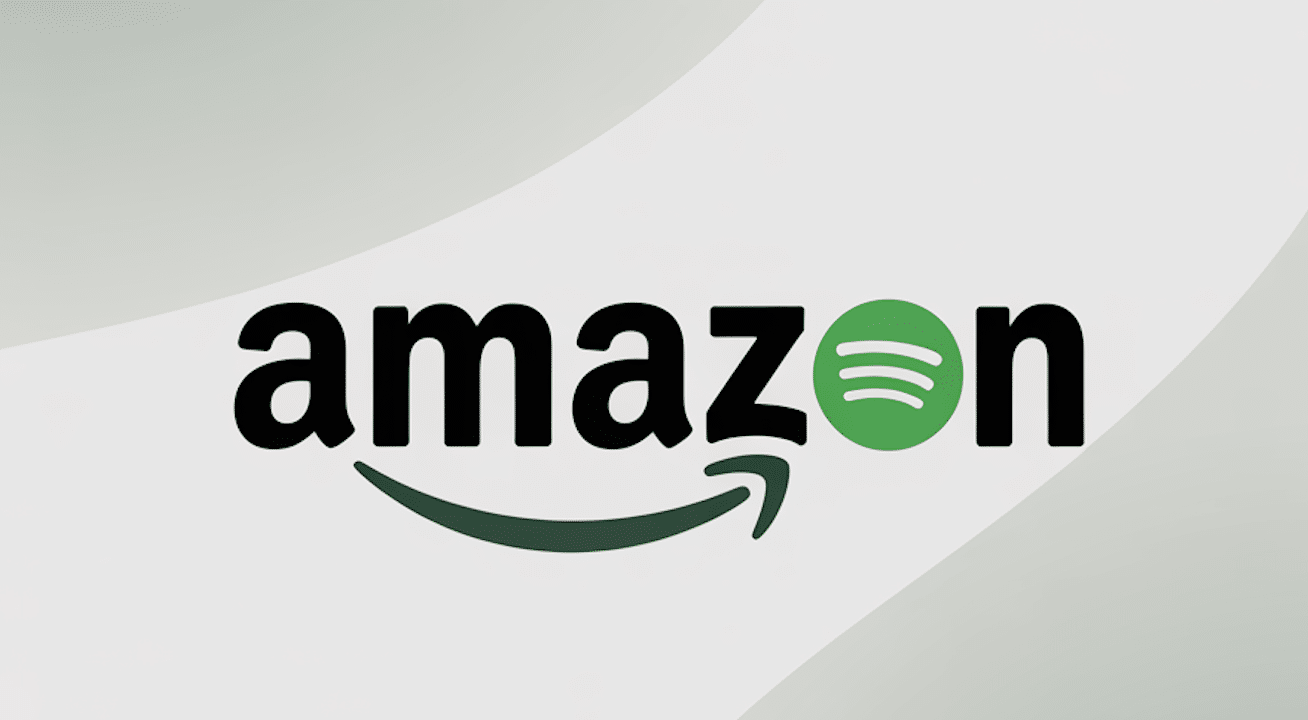Amazon Store Secrets: How Top Brands Build Million-Dollar Marketplace Destinations
Transform scattered product listings into a cohesive brand destination that drives explosive profits through strategic Store optimization.

Most Amazon sellers treat their marketplace presence like a collection of individual product listings – then wonder why they struggle to build lasting customer relationships or defend against competitors.
The reality is that sustainable Amazon success requires more than scattered SKUs competing on price. It demands a cohesive brand experience that transforms casual browsers into loyal customers who return again and again.
At Canopy Management, our human-led, software-driven approach has helped partners achieve an average 84% year-over-year profit increase by recognizing a fundamental truth: Amazon Store optimization means branded destinations that increase customer lifetime value, improve conversion rates across your entire catalog, and provide the algorithmic benefits that come from demonstrating genuine brand authority.
While individual product listing optimization remains crucial, Amazon Stores represent the evolution from single-product selling to comprehensive brand building within the marketplace. For brands enrolled in Amazon Brand Registry, Stores offer the opportunity to create immersive, multi-page experiences that rival traditional e-commerce websites while leveraging Amazon’s massive customer base and fulfillment infrastructure.
Understanding How Amazon’s Algorithm Rewards Brand Excellence
Amazon’s search algorithm has evolved significantly beyond simple keyword matching to consider comprehensive brand performance signals. This evolution fundamentally changes how successful brands approach marketplace optimization and presents new opportunities for those who understand these dynamics.
Beyond Individual Product Performance
The algorithm considers your entire brand ecosystem. When customers engage with your Amazon Store, explore multiple products, and demonstrate higher session duration, these signals indicate brand strength that the algorithm rewards with improved organic rankings across your complete catalog.
Brand-Level Algorithmic Benefits
Modern Amazon ranking systems place greater emphasis on customer engagement metrics, including click-through rates, time spent on product pages, and cross-product browsing behavior. Store engagement creates positive feedback loops where brand discovery leads to deeper catalog exploration, signaling to Amazon that your brand provides exceptional customer value.
The Compound Effect of Brand Authority
When customers discover your brand through one product but explore others through your Store, Amazon interprets this as strong brand appeal. This engagement depth creates algorithmic benefits that extend to new product launches, seasonal campaigns, and competitive positioning throughout your category.
Ready to Start Growing Your Amazon Brand?
Canopy’s Partners Achieve an Average 84% Profit Increase!
Find out moreMastering the Foundation: Individual Product Listing Optimization
Before diving into Store-level strategy, your individual product listings must convert traffic effectively. Partners who achieve exceptional Store performance always start with optimization fundamentals that create the foundation for brand-level success.
Strategic Title Construction for Algorithm and Human Appeal
Effective Amazon titles balance keyword optimization with customer readability. The most successful titles follow a clear hierarchy: Brand + Primary Keyword + Key Feature + Size/Quantity + Secondary Benefit, while staying within Amazon’s character limits and avoiding excessive special characters.
Bullet Points That Address Customer Intent
Your bullet points serve dual purposes: providing essential information for the algorithm and addressing customer concerns that prevent purchases. Focus on benefits rather than features, anticipate common objections, and include keywords naturally within compelling copy that speaks directly to your target customer’s specific needs and desires.
Advanced Keyword Research Beyond Traditional Tools
While keyword research tools provide valuable data, the most effective optimization comes from understanding customer intent throughout their entire journey. Analyze competitor listings, review customer questions and feedback, and consider the complete path from problem recognition to purchase decision—including the role your Store will play in that journey.
Visual Storytelling That Builds Brand Connection
High-quality product images significantly impact conversion rates and customer engagement. Your main image should clearly show the product against a clean background, while additional images demonstrate use cases, size comparisons, and key benefits. Amazon A+ Content extends this storytelling with lifestyle imagery and detailed feature explanations that begin building the brand narrative your Store will complete.

Your Comprehensive Brand Destination
Amazon Stores transform your marketplace presence from a collection of individual listings into a cohesive brand experience. Available to sellers enrolled in Amazon Brand Registry (which requires trademark registration), Stores provide the canvas for creating immersive destinations that build customer relationships extending far beyond single transactions.
Understanding Amazon Brand Registry Requirements
To access Amazon Stores, you must first enroll in Amazon Brand Registry. This program requires an active registered trademark or pending trademark application for your brand name or logo, issued by designated government trademark offices. Your brand logo must be permanently affixed to your products or packaging, and you must be the trademark owner or authorized representative.
Key Features That Drive Store Success
Multi-Page Brand Architecture
Amazon Stores offer sophisticated multi-page layouts that organize your products into logical categories, feature your best sellers prominently, and tell your brand story through rich media content. Custom navigation menus guide customers through your catalog intuitively, while built-in analytics provide insights into customer behavior that individual product pages cannot match.
Rich Media Integration for Deeper Engagement
The ability to incorporate videos, lifestyle imagery, and interactive content creates engagement opportunities that build brand connection and increase average order values. Unlike individual listings, Stores allow you to control the entire customer journey from initial discovery through final purchase, creating experiences that encourage exploration and repeat visits.
Store-Specific Analytics and Optimization Opportunities
Amazon’s Store Insights provide detailed analytics about customer behavior within your Store, including page views, engagement rates, and conversion paths that guide optimization decisions. These metrics reveal patterns in customer navigation, identify high-performing content, and highlight opportunities for improvement that simply aren’t available at the individual listing level.
How Store Optimization Differs from Product Listing Optimization
Holistic Brand Experience vs. Single-SKU Focus
Store optimization requires a comprehensive approach that considers brand narrative, customer journey design, and cross-product relationships. While individual listing optimization focuses on single-SKU performance, Store optimization creates ecosystems that encourage exploration, comparison, and multiple purchases within a single session.
Navigation and User Experience Complexity
The navigation and user experience elements crucial for Store success are entirely different from individual listing optimization. Store success depends on intuitive category organization, logical product groupings, and seamless transitions between pages—considerations that don’t exist for standard product listings.
Content Depth and Storytelling Opportunities
Stores allow for rich, multimedia content and curated collections that are impossible within standard product page constraints. This content depth enables storytelling, brand positioning, and cross-selling opportunities that individual listings simply cannot accommodate, creating genuine competitive advantages for brands that leverage these capabilities effectively.
Traffic Strategy Integration
With Amazon’s algorithm evolution prioritizing engagement quality and external traffic sources, Stores serve as ideal destinations for external marketing campaigns and brand-building efforts. The ability to direct social media traffic, influencer partnerships, and content marketing efforts to a branded Store rather than individual listings creates more professional impressions and better conversion opportunities.
Essential Store Optimization Best Practices
Consistent Brand Identity Across All Pages
Successful Amazon Stores maintain consistent branding across every page, from color schemes and typography to messaging tone and visual style. This consistency builds brand recognition and trust while creating the professional appearance that encourages customer confidence and repeat visits.
Intuitive Product Category Structure
Your Store structure should mirror how customers think about your products, not necessarily how you organize inventory internally. Group products by use case, customer type, or problem solved rather than by technical specifications or manufacturing categories. This customer-centric organization improves navigation and increases cross-selling opportunities.
Dynamic Homepage Optimization
Your homepage serves as your digital storefront window, requiring careful curation of featured products, compelling imagery, and clear value propositions that encourage deeper exploration. Regular content updates featuring seasonal collections, new products, and promotional campaigns keep your Store fresh and provide reasons for customers to return.
Data-Driven Store Insights Optimization
Amazon’s Store analytics provide comprehensive data about traffic patterns, conversion metrics, and customer behavior that should guide all optimization decisions rather than assumptions or generic best practices. Regular analysis of these metrics reveals opportunities for layout improvements, content optimization, and navigation enhancements.
Strategic Store Setup and Navigation Design
Creating an effective Amazon Store begins with understanding your customer’s shopping journey and organizing your catalog to support natural browsing patterns while encouraging discovery and cross-selling.
Store Architecture That Converts
Customer-Centric Category Organization
Your Store structure should reflect customer thinking patterns rather than internal business logic. Categories like “Best Sellers,” “New Arrivals,” “Problem-Specific Solutions,” or “Customer Favorites” often perform better than technical product classifications because they match how customers actually shop and make decisions.
Homepage as Strategic Gateway
Your homepage requires careful curation that balances multiple objectives: showcasing flagship products, highlighting current promotions, introducing brand story elements, and providing clear pathways to deeper catalog exploration. The most successful Store homepages change regularly to reflect seasonal trends, new product launches, and promotional campaigns.
Navigation Psychology for E-commerce Success
Effective Store navigation reduces cognitive load while encouraging discovery. Use clear, descriptive category names that customers would naturally search for, ensure important categories are accessible within two clicks from any page, and implement breadcrumb navigation and search functionality to help customers orient themselves within your Store.
Cross-Linking Strategy for Increased Session Value
Strategic cross-linking between related products and categories increases session duration and average order values. Product bundles, “frequently bought together” suggestions, and curated collections create natural paths for customers to discover complementary items while building stronger relationships with your brand.
Mobile Optimization for Store Success
With mobile traffic representing the majority of Amazon visits, mobile optimization becomes crucial for Store success. Ensure your Store design works seamlessly across all devices, with particular attention to navigation simplicity, image loading speeds, and touch-friendly interface design that creates positive experiences regardless of device type.
Ready to Start Growing Your Amazon Brand?
Canopy’s Partners Achieve an Average 84% Profit Increase!
Find out moreComprehensive Traffic Generation for Store Growth
Store optimization extends beyond internal design to encompass sophisticated traffic generation strategies that leverage both Amazon’s advertising ecosystem and external marketing channels for maximum brand exposure and customer acquisition.
Internal Traffic Generation Through Amazon’s Advertising Platform
Sponsored Brand Campaigns for Store Traffic
Sponsored Brand ads serve as primary drivers of Store traffic, allowing you to showcase multiple products while directing customers to your branded destination. These campaigns should highlight your most popular or profitable products while using Store-specific landing pages that create cohesive experiences from ad click through purchase completion.
Strategic Product Selection for Store Discovery
Sponsored Products campaigns can drive Store traffic when configured to promote flagship products that serve as gateway purchases to your broader catalog. The key is creating product selection and bidding strategies that prioritize profitable customer acquisition and Store exploration over short-term return on ad spend optimization alone.
Promotional Integration for Traffic Amplification
Amazon’s promotional tools, including Lightning Deals and coupons, can increase Store traffic when strategically integrated with Store-specific landing pages. External advertising campaigns that drive traffic during promotional periods often see higher conversion rates and increased average order values.
External Traffic Strategies That Build Brand Equity
Social Media Marketing Integration
Social media marketing, influencer partnerships, and content marketing efforts become more powerful when directed to Amazon Stores rather than individual product listings because Stores create more professional impressions and provide opportunities for brand storytelling that individual listings cannot match.
Content Marketing and Search Engine Optimization
Content marketing efforts that drive qualified traffic to your Store can improve both external visibility and internal Amazon performance metrics. Blog content, educational resources, and brand storytelling that naturally direct interested customers to your Amazon Store create valuable traffic that demonstrates genuine customer interest.
Email Marketing for Customer Retention
Email marketing campaigns to existing customers can drive repeat purchases and increase customer lifetime value when they direct traffic to curated Store sections featuring new products, seasonal collections, or exclusive bundles rather than individual product pages.
Attribution and Analytics for Performance Optimization
Amazon Attribution for External Traffic Tracking
Amazon Attribution tracking becomes crucial for Store optimization, allowing you to understand which external traffic sources generate the highest-value customers. This data informs both advertising spend allocation and content strategy decisions for ongoing improvement and budget optimization.
Store Insights for Internal Optimization
Store Insights provide detailed analytics about customer behavior within your Store, including page views, engagement rates, and conversion paths that guide optimization decisions and content updates. Regular analysis of these metrics reveals patterns in customer navigation and identifies opportunities for improvement.

Advanced Conversion Rate Optimization for Store Success
Store conversion optimization requires understanding the unique dynamics of multi-product browsing behavior and the factors that influence customers to make multiple purchases or return for future shopping sessions.
Brand-Level Social Proof Development
Customer Testimonials and Success Stories
While individual product reviews remain important, Store-level social proof comes from showcasing customer testimonials, user-generated content, and brand recognition that builds trust across your entire catalog. Feature customer success stories and lifestyle imagery that demonstrates your products in real-world contexts throughout your Store.
Brand Storytelling for Emotional Connection
Brand storytelling within your Store should highlight your company’s mission, values, and unique selling propositions that differentiate you from competitors and create emotional connections with customers. This storytelling creates the brand equity that supports premium pricing and customer loyalty.
Strategic Pricing and Inventory Management
Cross-Product Pricing Strategy
Store-level pricing strategy should consider cross-product relationships and customer lifetime value rather than optimizing individual SKUs in isolation. Bundle opportunities, volume discounts, and strategic loss leaders can increase average order values while building customer loyalty and encouraging repeat purchases.
Inventory Management for Store Success
Inventory management becomes more complex but more profitable when viewed through a Store lens, as popular products can drive traffic that converts on complementary items with higher margins or better availability. Strategic inventory allocation ensures that Store traffic converts effectively across your complete catalog.
Customer Journey Optimization
Navigation Flow Analysis
Understanding how customers move through your Store reveals opportunities for optimization that individual product metrics cannot capture. Analyze common navigation paths, identify drop-off points, and optimize page transitions to encourage deeper exploration and higher conversion rates.
Cross-Selling and Upselling Integration
Effective Store design creates natural opportunities for cross-selling and upselling that feel helpful rather than pushy. Product groupings, curated collections, and strategic placement of complementary items can significantly increase average order values while improving customer satisfaction.
Performance Monitoring and Data-Driven Optimization
Amazon Store optimization requires systematic monitoring, testing, and refinement based on performance data and evolving customer behavior patterns rather than assumptions or generic best practices.
Key Metrics That Drive Store Success
Engagement Metrics Beyond Basic Conversion
Store performance extends beyond simple conversion rates to include metrics like pages per session, time spent browsing, return visitor rates, and cross-product purchase patterns. These engagement metrics provide insights into brand strength and customer satisfaction that individual product metrics cannot capture.
Traffic Source Analysis for Marketing Optimization
Understanding which traffic sources drive the highest-value customers helps optimize marketing spend and content strategy. External advertising campaigns directed to well-optimized Stores often generate positive effects across non-advertised products through increased brand awareness and customer exploration.
Conversion Funnel Analysis
Store-level conversion funnel analysis identifies opportunities for improvement throughout the customer journey, from initial Store entry through final purchase and potential repeat visits. This analysis reveals optimization opportunities that individual product analysis cannot identify.
Iterative Testing and Continuous Improvement
A/B Testing for Store Elements
Successful Store optimization requires ongoing testing of layouts, content, navigation structures, and promotional strategies. A/B testing different homepage designs, category structures, and product presentation formats provides data-driven insights for continuous improvement rather than guesswork.
Seasonal Optimization Strategies
Regular content refreshes keep your Store dynamic and capitalize on changing customer needs throughout the year. Seasonal updates, holiday promotions, and trend-responsive content demonstrate brand relevance and provide reasons for customers to return regularly.
Content Performance Analysis
Tracking which content types, product presentations, and Store sections generate the highest engagement and conversion rates guides future content creation and optimization decisions. This data-driven approach ensures resources are allocated to the most effective Store elements.
Advanced Strategies and Common Optimization Pitfalls
Leveraging Emerging Amazon Features for Competitive Advantage
Amazon Posts and Brand Story Integration
Amazon Posts and Brand Stories provide opportunities for enhanced brand visibility and customer engagement when integrated strategically with Store optimization efforts. Early adoption of new features often provides temporary competitive advantages before they become standard practice among competitors.
Cross-Promotion with Amazon’s Advertising Ecosystem
Integration with Amazon’s complete advertising ecosystem, including Display ads and video advertising, can amplify Store traffic and brand awareness when campaigns are designed to work synergistically rather than in isolation.
Critical Store Optimization Mistakes to Avoid
Treating Stores as Static Brochures
The most common Store optimization mistake is treating Stores as static brochures rather than dynamic shopping destinations. Successful Stores require regular content updates, seasonal refreshes, and ongoing optimization based on performance data and customer feedback.
Neglecting Mobile Experience
With mobile traffic dominating Amazon usage, failing to optimize Store design and navigation for mobile devices severely impacts performance. Mobile optimization includes image loading speeds, simplified navigation, and touch-friendly interface design.
Poor Category Organization and Navigation
Technical mistakes like confusing navigation, slow-loading images, and poor category organization can severely impact Store performance. Strategic mistakes like weak calls-to-action and poor product groupings prevent conversion optimization from reaching its potential.
Frequently Asked Questions About Amazon Store Optimization
Q: How long does it take to see results from Store optimization?
A: Most brands see initial improvements in Store engagement metrics within 4-6 weeks of optimization, with significant traffic and conversion improvements typically visible within 90 days of consistent optimization efforts.
Q: What’s the difference between Store traffic and individual listing traffic?
A: Store traffic includes all visits to your branded Store pages, while individual listing traffic only counts visits to specific product pages. Store traffic often shows higher engagement rates and longer session durations due to the branded experience.
Q: Can I track Store performance with external analytics tools?
A: While Amazon’s built-in Store Insights provide comprehensive data, third-party tools can offer additional analysis capabilities when properly configured with UTM parameters and attribution tracking.
Q: Do Amazon Stores improve organic ranking for individual products?
A: Yes, Store engagement signals and brand-level performance metrics contribute to improved organic rankings across your entire catalog through Amazon’s algorithm that considers brand authority and customer engagement.
Q: What’s the most important Store optimization factor? A: Customer navigation experience and brand storytelling integration create the foundation for Store success, but ongoing optimization based on Store Insights data drives the most significant performance improvements.
The Canopy Management Advantage: Human-Led Store Optimization Excellence
At Canopy Management, we’ve built our reputation on delivering transformational results through our human-led, software-driven approach to Amazon optimization. Our partners don’t just see incremental improvements – they achieve exceptional growth averaging 84% year-over-year profit increases because we understand that Store optimization requires both technical expertise and strategic brand thinking.
Our white-glove service means you’re gaining a dedicated partner who treats your brand’s success as our own. We combine deep Amazon expertise with comprehensive brand strategy to create integrated Store experiences that drive both immediate sales and long-term customer relationships.
Unlike agencies that rely heavily on AI automation, we believe in the power of human insight combined with sophisticated tools. Our team includes former Amazonians, multi-million dollar sellers, and award-winning marketing experts who understand both the technical requirements of Amazon’s algorithm and the creative demands of effective brand storytelling.
Our Store Optimization Process:
- Comprehensive brand and competitor analysis to identify unique positioning opportunities
- Data-driven Store architecture design that optimizes for customer journey and conversion
- Human-crafted content and storytelling that builds genuine brand connections
- Ongoing optimization based on performance data and algorithmic changes
- Integration with external marketing efforts for maximum traffic generation and brand building
Your Path to Amazon Store Excellence
Amazon Store optimization represents the evolution from individual product selling to comprehensive brand building within the marketplace. The brands achieving exceptional growth understand that success demands authentic brand experiences that build customer relationships and create sustainable competitive advantages.
The most successful Amazon brands start with strategic Store optimization and refine their approach based on performance data and customer feedback. Your Store optimization journey begins with understanding your customers’ needs and creating experiences that exceed their expectations while driving profitable growth.
Ready to transform your Amazon presence from scattered product listings to a cohesive brand destination?
Canopy Management is a full-service marketing agency for Amazon, Walmart, and TikTok sellers. Our team consists of multi-million dollar, omni-channel entrepreneurs, industry leaders, and award-winning experts.
Ready to Start Growing Your Amazon Brand?
Canopy’s Partners Achieve an Average 84% Profit Increase!
Find out more

